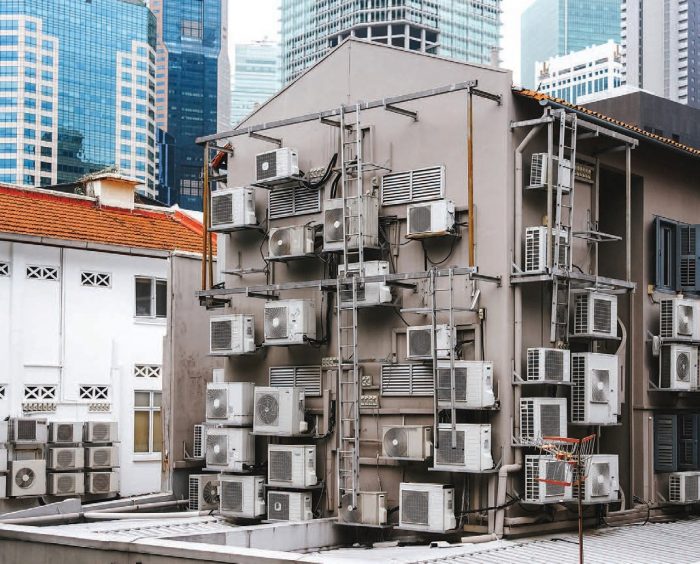It’s World Refrigeration Day – and keeping our cool the right way has never been so important
Sunday (26 June) is World Refrigeration Day and the theme this year is ‘Cooling Matters’ – so why does cooling matter?
Cooling is an essential part of our lives – it keeps our food fresh, our medicines and vaccines viable, our homes and offices at manageable temperatures, keeps data centres cool to allow us to use the internet and is used for many industrial and manufacturing processes.
In many parts of the world, air-conditioning is seen as a luxury for staying comfortable, but with increasing global temperatures and the rising frequency and severity of extreme heatwaves, it is increasingly a necessity for human life.
However, cooling comes at a cost to our climate and environment – not only does cooling equipment use vast amounts of energy, a lot of equipment also relies on climate-damaging refrigerant gases such as hydrofluorocarbons (HFCs).
HFCs leak into the atmosphere during the lifetime of the cooling products and again when the equipment is disposed of at the end of its life. Given their short lifetimes and high global warming potentials (GWPs), these released HFCs have significant impact on warming the atmosphere and contributing to the climate crisis.
You may never have heard of HFCs, but the chances are that you use them in your life every day. You can find HFCs in supermarkets, office and home air-conditioning, data centres, ice rinks, asthma inhalers, dairy manufacturing, heat pumps and even for beauty treatments that cool the skin. Despite their outsized impact on climate change, the use of HFCs is growing; as a family of gases, they had the highest relative growth in emissions from 1990 to 2019, according to the UN Intergovernmental Panel on Climate Change (IPCC).
HFCs are the third generation of fluorinated greenhouse gases to be used in cooling. Before HFCs we had chlorofluorocarbons (CFCs) and hydrochlorofluorocarbons (HCFCs), which have been or are being phased out by the Montreal Protocol due to their role in depleting the ozone layer.
HFCs were developed to replace these harmful gases; however, recognition of their climate impact led the international community to agree a phase-down of these gases under the Kigali Amendment to the Montreal Protocol.
The fluorochemical industry is now creating, patenting and marketing a new family of synthetic refrigerants called hydrofluoroolefins (HFOs) and developing multiple new HFC blends mixing high-GWP HFCs with HFOs in order to market them as climate-friendly alternatives.
They’re not. While HFOs have low GWPs, there are serious concerns about the environmental impacts of the by-products and breakdown products of HFOs. HFOs and one of the breakdown products (trifluoroacetic acid, or TFA) are perfluoroalkyl and polyfluoroalkyl substances (PFAS), more alarming known as ‘forever chemicals’.

Air-conditioning units in Singapore – as the world warms, keeping cool without worsening the situation is vital (c) EIA
These chemical could soon be further regulated in the EU and the US; their toxic and persistent bioaccumulative effects have resulted in severe contamination of soil, water and food as well as harmful exposure to humans. HFOs are also more expensive and open loopholes and opportunities for exacerbating the illegal trade in HFCs.
Fortunately, HFOs and HFO/HFC blends are not the only available alternatives. Natural refrigerants have been used in cooling equipment for more than a century and are increasingly staging a comeback due to their negligible environmental and climate impacts and high efficiencies.
New international safety standards, including one for household air-conditioners and heat pumps, enable the safe use of larger amounts of flammable refrigerants, including natural refrigerant propane. Given the expected meteoric rise in demand for air-conditioning (with the global stock of air-con units set to triple by 2050), a switch to propane units could be a game-changer for the industry and the climate, potentially saving up to 5.6 billion tonnes of CO2 equivalent emissions by 2050.
Heat pumps are increasingly being seen as a useful weapon against climate change and dependence on Russian gas. However, most heat pumps on the market also contain HFCs. The new standard will enable the roll-out of heat pumps running on propane, so the decarbonisation of homes can be truly green.
We are in a climate emergency and, with the world heating up, cooling will increasingly matter for human wellbeing, productivity and even survival.
This is a critical time for governments and businesses around the world to focus on future-proof, environmentally sustainable options and avoid false solutions which will only create new environmental challenges for future generations.





